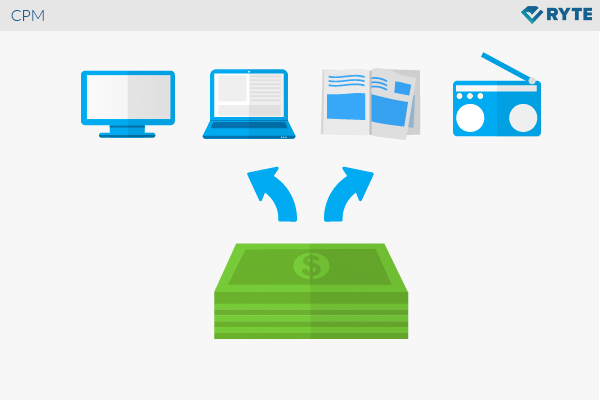CPM
CPM is short for Cost Per Mille, and also referred to as CPT (Cost Per Thousand) or TAI (Thousand Ad Impressions). It is a key figure for the calculation of the advertising rate of print, online, tv or radio advertising on the basis of the possible visual contact for the advertising media. For instance, ads in Google AdWords or in Blind Network can optionally be calculated with CPM. The CPM determines how much advertisers need to pay in order to have 1.000 visitors or readers noticing an ad or a banner.
Calculation
The contact of the subject with the advertising medium as well as the gross range serve as basis for the calculation of the CPM. Depending on the medium, different definitions apply for the contact:
- TV: a contact is the visual contact with the advertising material as measured by a program’s range
- Radio: a contact is the audio contact as measured by a program’s range
- Print: a contact is the visual contact as measured by a print medium’s circulation
- Online: a contact can be equated with an Ad-Impression or Pageview
Alternatively, the reach can also be indicated as net range. For means of distinction:
Gross range: At this, multiple contact is being included into the calculation. A contact with an advertising medium can take place through various readers, listeners or users, e.g. a radio program and therefore a commercial can be listened to by various people in an office, just as a magazine can be read by various patients in a doctor’s waiting room. Net range: Here it is assumed that only one person perceives the advertising material. For example, this is the case when talking of “unique visitors” of a website in the case of evaluating Online Media.
The formula for the calculation can be drawn up as follows: The CPM is the result from advertising cost divided by gross range multiplied with 1.000.
Example: A website is called up 1.000.000 times per month. The costs for the ad’s monthly insertion amount to €10.000. The calculation looks as follows: CPM = (Advertising cost) / (gross range (e.g. page impressions)) x 1.000 = (€10.000) / (1.000.000) x 1.000 = €10
The CPM for this insertion would then amount to €10. Conversely, the costs for an insertion can also be calculated if 1.000.000 people shall be reached with a CPM of €10: Advertising costs = (€10 x 1.000.000) / (1.000) = €10.000
Price Calculation
A media planner who wants to generate 1.000.000 page impressions with his banners would have to pay €10.000 at a CPM of €10.
Apart from the medium’s range, the actual amount of the CPM also depends on the placing of the advertising material. A simple banner is thus a lot cheaper than a wallpaper. Additionally, the factor “rotation” also determines the price. In addition, the thousand contact price is also determined by the range and reputation of the respective medium. Advertisers will certainly have to pay more for advertising on a prestigious online news portal with more than 100,000 visitors per day than on a website of hobby insect researchers who reach only a few thousand users per month.
It makes a difference whether an advertising banner is fixed or has to compete with other ads.
Benefits of the CPM
With the help of the CPM, costs for the purposes of media planning in online marketing as well as print advertising can be scaled more precisely. Beyond that, costs for the insertion on different channels can be compared on the basis of the CPM. Like that, advertisers can evaluate the respective advertising channels and draw crossmedia comparisons. An example: With the help of the CPM, advertising planners can estimate whether to lower or increase the budget on inviting offers for radio, print or online advertising.
Drawbacks of the CPM
You can’t deduce a contact’s quality with the advertising medium from the CPM – it’s merely a quantitative benchmark. With online advertising, it is often crucial whether the calculation of the CPM is based on the website’s visits, page impressions or unique visits. With calculating the CPM for TV or radio, the qualitative aspect is even lower, as usually, representative surveys or market research is applied in order to identify a station’s range.
Web Links

